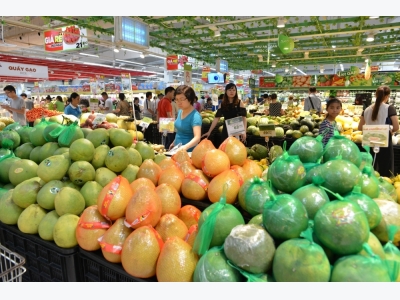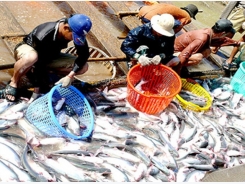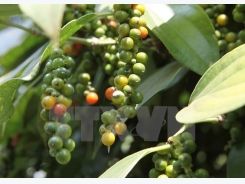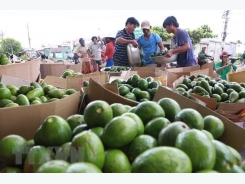Fruit and vegetable exports yield sweet results

Moving ahead of rice, oil and gas - Vietnam’s traditional and key export products - fruit and vegetable topped the list of agricultural exports in 2017 with value reaching a record high US$3.5 billion. In 2018 and ensuing years, the export value of the fruit and vegetable sector is forecast to remain as high or even reach higher levels.
Fruit and vegetables have grown into key Vietnamese agricultural exports
Dragon fruit and longan
According to the Vietnam Fruit and Vegetables Association, Vietnam exported more than US$3.5 billion worth of fruit and vegetables in 2017, a rise of 43 percent compared with 2016. This was the highest export value of these products ever recorded by Vietnam. China, Japan, the US and the Republic of Korea (RoK) were the top four importers of Vietnamese fruit and vegetables in the past 11 months. Exports to Japan grew 70.6 percent in 2017 compared with 2016; to the United Arab Emirates, up 57.4 percent; and to China, up 54.9 percent. Vietnamese fruit and vegetables are exported to more than 40 countries and territories.
The export growth is attributed to new markets located and opened up by ministries, sectors, associations and businesses. Apart from China, Vietnam has exported five kinds of fresh fruit (dragon fruit, rambutan, litchi, longan and mango) to discerning markets, including the US, the RoK, Japan, New Zealand, Australia, Chile and Chinese Taipei. The export volume of these fruit totaled more than 10,350 tonnes in 2017.
Dragon fruit and longan top the export list. The US was the largest importer, with 4,572 tonnes of dragon fruit and 2,681 tonnes of longans, a tribute to the fruits’ stable quality, professional packaging and easy air or sea shipment.
By the end of 2017, dragon fruit, rambutan, litchi, longan, mango and star-apple farmers nationwide had been provided with 352 production unit codes for growing areas totaling 6,355ha, which yield nearly 155,700 tonnes of fruit per year for export to discerning markets. Recently, Vietnam was granted an additional three production unit codes for star-apple growing areas totaling 33ha, which yield about 330 tonnes of fruit per year for export to the US. The whole country has 38 packaging facilities and seven treatment facilities meeting international standards.
A US$7 billion dream
According to the Ministry of Industry and Trade (MoIT), there’s still much room for Vietnam to increase fruit and vegetable exports. Global import value of these products has exceeded US$200 billion per year since 2011, while Vietnamese fruit and vegetables account for just a small market share, slightly more than one percent.
The Vietnam Fruit and Vegetables Association predicted the export value of fruit and vegetables would possibly reach US$4.5 billion by 2020, up more than 80 percent compared with 2016, with fruit exports expected to account for about US$3.6 billion. The export value is forecast to exceed US$7 billion by 2030, including more than US$6 billion worth of fruit exports. The association also predicted a trade surplus of more than US$1.5 billion for the fruit and vegetable sector by 2030.
To make these forecasts come true, the MoIT is coordinating with the Ministry of Agriculture and Rural Development to restructure the agricultural sector and build closed production chains to increase the added value by creating products that meet importer requirements in terms of quality and food safety. Trade promotion activities will be intensified to boost exports to potential markets that have signed free trade agreements with Vietnam. Along with promoting exports to new markets, the sector will maintain exports to traditional markets, especially China.
High-tech agriculture will be promoted to create high-quality products, for example growing flowers without using soil, chemicals and pesticides. Export markets will be diversified to minimize risks. Brand building will be prioritized to restrict exports via intermediaries.
For their part, businesses and farmers should pay greater attention to ensuring food safety, as well as to processing and preservation techniques. Efforts should be focused on building brands for local specialties, such as king banana, litchi, longan, dragon fruit, grapes, mango, grapefruit and oranges.
In 2018 and ensuing years, along with improving the quality of fruit and vegetables, businesses should increase investment in processing because the export value of processed fruit can be 10-20 times higher compared with fresh fruit. Moreover, while only 40-50 percent of the output can be exported in fresh form, 100 percent can be processed for export.
Major export markets for Vietnamese fruit and vegetables include China, the RoK, Japan, Thailand, Singapore and Malaysia. Some kinds of Vietnamese fruit have been accepted by discerning markets with strict requirements in terms of product quality, such as Australia and the US.
Có thể bạn quan tâm
Phần mềm

Phối trộn thức ăn chăn nuôi

Pha dung dịch thủy canh

Định mức cho tôm ăn

Phối trộn phân bón NPK

Xác định tỷ lệ tôm sống

Chuyển đổi đơn vị phân bón

Xác định công suất sục khí

Chuyển đổi đơn vị tôm

Tính diện tích nhà kính

Tính thể tích ao hồ



 Value adding problem for pepper
Value adding problem for pepper  Vietnam seeks to accelerate agricultural restructuring
Vietnam seeks to accelerate agricultural restructuring